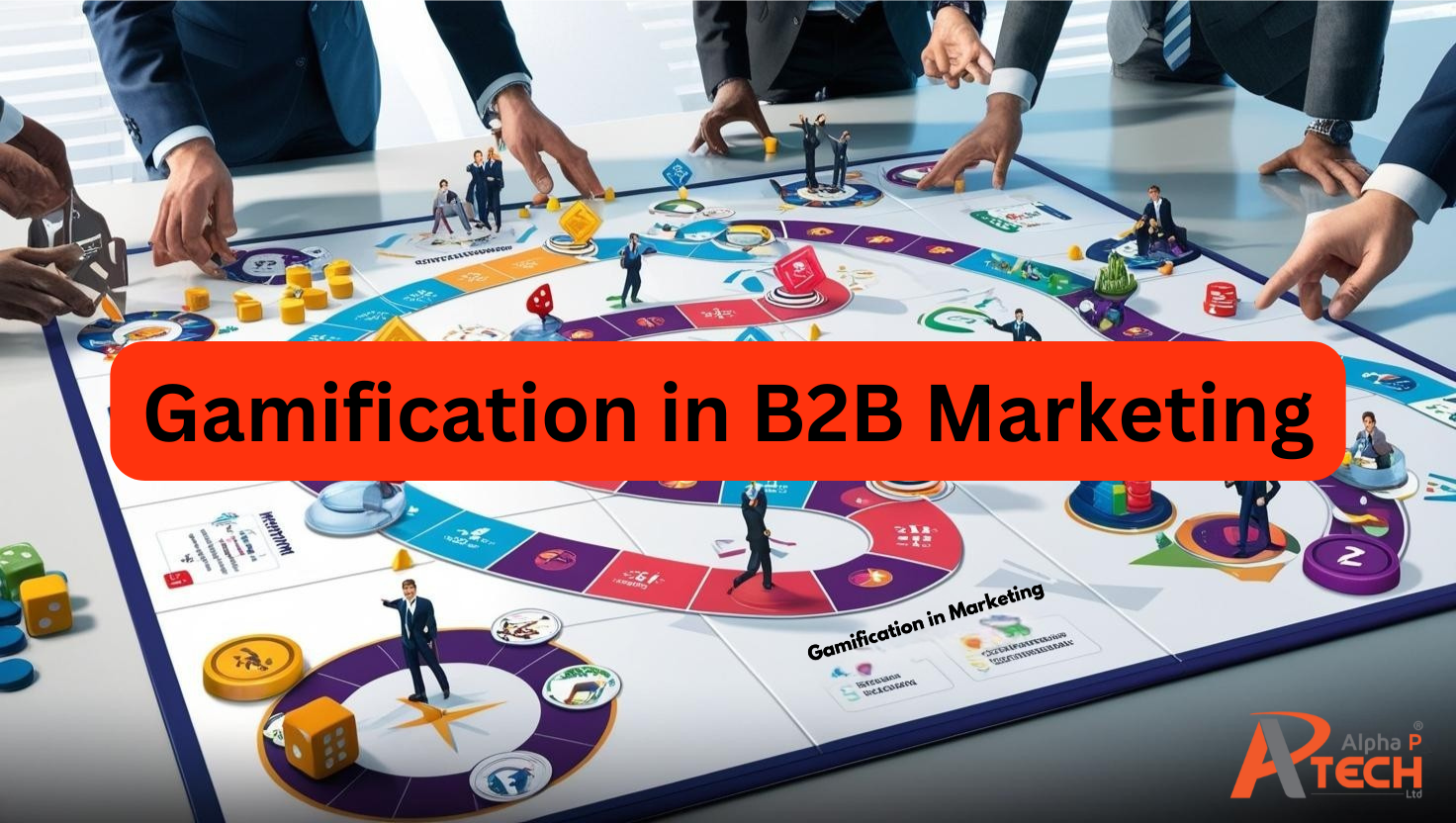Prefer to listen instead? 🎧
We’ve turned this article into a full deep dive video—watch it here
to explore the campaigns in a more engaging format.
The Power of Gamification in B2B Marketing
In an increasingly competitive digital landscape, businesses are constantly searching for innovative ways to capture attention and drive engagement. Gamification in marketing has emerged as a powerful tool, leveraging game-like elements such as rewards, challenges, and interactive content to enhance customer experience.
While often associated with consumer brands, gamification is proving to be a game-changer in B2B marketing strategies, helping businesses foster stronger relationships, improve lead generation, and increase client retention. By integrating elements of play into B2B content marketing, agencies and brands can create more immersive and rewarding experiences that encourage prospects to engage more deeply with their services.
In this article, we will explore how gamification can be effectively implemented in B2B settings, the key strategies that drive success, and how agencies can use these techniques to differentiate themselves, boost conversions, and build lasting client relationships.
What is Gamification in Marketing?
At its core, gamification in marketing involves integrating game-like elements—such as point systems, leaderboards, challenges, and rewards—into marketing campaigns to drive engagement and incentivise specific behaviours.
While traditionally associated with consumer brands, gamification is becoming a strategic asset in B2B marketing strategies, offering a fresh and interactive approach to nurturing client relationships, enhancing brand recall, and streamlining lead generation. Unlike B2C campaigns that often focus on entertainment and viral engagement, B2B applications are designed to enhance education, onboarding, and customer retention.
Research by Mordor Intelligence underscores its effectiveness: gamified content can boost engagement and loyalty by an average of 30%. Additionally, businesses adopting gamification strategies have experienced a 25.3% increase in sales conversions. As more B2B enterprises seek differentiation in saturated markets, gamification presents an opportunity to create compelling, data-driven, and engaging customer experiences.
Why Gamification in B2B Marketing Drives Engagement & Growth
The effectiveness of gamification in marketing is rooted in fundamental psychological principles such as motivation, competition, and rewards. Humans are naturally wired to seek achievement, recognition, and progress, making gamified experiences highly engaging. In B2B marketing strategies, where sales cycles are often long and decision-making is complex, gamification can be a powerful tool to sustain client engagement over time. By incorporating game-like elements such as milestone rewards, interactive challenges, and leaderboards, businesses can keep prospects engaged at different stages of the buying journey while making the experience more dynamic and rewarding.
Gamification also offers a strategic advantage in B2B content marketing, helping brands differentiate themselves in an increasingly saturated market. Rather than relying on traditional static content, businesses can create interactive experiences that captivate potential clients and encourage deeper brand interaction. Furthermore, by fostering competition and incentivising participation, gamification enhances brand loyalty and encourages repeat business.
A prime example of this in action is Sharedserviceslink.com, a UK-based online community for finance shared services professionals. To increase user engagement, they launched a gamified website experience that rewarded participation with points and badges. As a result, website visits increased by 108%, and unique website visits grew by 99.8%.
This case demonstrates how gamification can successfully drive participation and brand interaction in even the most traditional B2B sectors. To achieve similar results, businesses need the right approach—let’s explore key gamification strategies that businesses can use to implement effectively.
Key Gamification Strategies to Boost B2B Marketing
Incorporating gamification into B2B marketing strategies can significantly enhance client engagement and foster stronger relationships.
Interactive Content
One effective approach is the use of interactive content, such as quizzes, surveys, and assessments, which provide personalised insights to potential clients. This not only captures their interest but also positions your business as a valuable resource, thereby enriching your B2B content marketing efforts.
Loyalty and Reward Systems
Implementing loyalty and reward systems is another impactful strategy. By offering points-based incentives for activities like engagement, referrals, or purchases, businesses can encourage repeat interactions and cultivate brand loyalty. This approach aligns with the principles of gamification in marketing, motivating clients through achievable rewards.
Progressive Learning & Certifications
Progressive learning and certification programmes can transform the onboarding process into an engaging experience. By gamifying training modules, clients are more likely to engage deeply with your products or services, leading to higher satisfaction and retention rates.
Leaderboards & Competitions
Leaderboards and competitions introduce a healthy sense of competition among clients. Ranking systems for customer participation, such as user-generated content contests, not only boost engagement but also foster a community around your brand. This method leverages the competitive nature inherent in many individuals, driving them to interact more frequently with your offerings.
Gamified Sales Incentives
Internally, gamified sales incentives can invigorate your sales teams. Creating sales challenges with clear goals and rewards can boost performance and morale, leading to increased productivity and better client acquisition outcomes.
By integrating these gamification strategies into your B2B marketing framework, you can create more engaging and effective campaigns that resonate with your target audience.
Implementing Gamification Without Losing Professionalism
While gamification in marketing is a powerful engagement tool, some B2B brands may hesitate, fearing that it could appear too playful or gimmicky for their professional audience. However, when implemented thoughtfully, gamification enhances customer experiences without undermining credibility.
The key lies in aligning gamification elements with brand identity and maintaining a balance between engagement and professionalism. Instead of flashy, game-like features, businesses can incorporate subtle yet effective mechanics that encourage participation. For example, interactive content such as industry-relevant quizzes or assessments can offer valuable insights while reinforcing expertise. Similarly, a well-structured points-based loyalty programme can reward clients for engaging with educational content or providing referrals, positioning the brand as both innovative and customer-focused.
Another strategic approach is incorporating progress tracking and certifications into training and onboarding experiences. By allowing clients to unlock achievements for completing learning modules, businesses can drive deeper engagement while reinforcing their authority in the industry. Leaderboards, when used in a B2B context, can motivate participation without appearing trivial—such as ranking contributors in a thought leadership forum or rewarding top-performing partners.
By embedding gamification subtly into B2B marketing strategies, brands can create an engaging, value-driven experience that enhances client relationships while preserving a polished and professional image.
Case Study: Mutiny’s “Surv-AI-vor” Campaign – Gamification in Action
A prime example of gamification in marketing delivering tangible results is Mutiny’s “Surv-AI-vor” campaign. As an AI-powered website personalisation company, Mutiny sought to educate users on AI workflows in a way that was engaging and interactive. Rather than relying on traditional B2B content marketing tactics, they introduced a gamified digital experience that immersed participants in an AI-driven challenge.
The campaign was structured as a competitive learning experience, where participants tested their knowledge and decision-making skills in simulated AI workflows. Through progress-based challenges, leaderboards, and rewards, Mutiny successfully encouraged deeper engagement with their platform.
The results were remarkable—a 40x return on investment (ROI), proving the effectiveness of gamification as part of a B2B marketing strategy. By transforming a complex technical topic into an interactive experience, Mutiny not only educated its audience but also increased brand awareness and customer acquisition.
For B2B agencies looking to implement similar strategies, the key takeaway is that gamification can make even the most technical subjects engaging. By integrating interactive content, competition, and incentives, businesses can enhance lead generation, boost retention, and position themselves as industry leaders—all while maintaining a professional brand image.
While successful campaigns like Mutiny’s ‘Surv-AI-vor’ showcase the immense potential of gamification, not all implementations deliver the desired results. Many B2B businesses face challenges when incorporating gamification into their marketing strategies. Here are some common pitfalls to watch out for and how to avoid them.
Common Pitfalls to Avoid When Using Gamification in B2B
While gamification in marketing can be a powerful tool for driving engagement, poorly executed strategies can lead to disengagement rather than increased interaction.
Overcomplicating the experience
One of the biggest mistakes businesses make is overcomplicating the experience. If the gamified elements are too difficult to understand or require too much effort, users may abandon the process entirely. Simplicity and clarity should always be prioritised.
Ignoring data and insights
Another common misstep is ignoring data and insights. Effective B2B marketing strategies rely on tracking engagement metrics to refine and optimise campaigns. Without analysing user behaviour, businesses miss opportunities to enhance their B2B content marketing efforts and improve overall performance.
Over-relying on extrinsic rewards
Additionally, many brands over-rely on extrinsic rewards, such as discounts or giveaways, without fostering intrinsic motivation. While rewards can drive short-term engagement, long-term success depends on delivering genuine value, such as educational content, personalised insights, or industry recognition.
Failing to align gamification with objectives
Finally, gamification should align with broader marketing and sales objectives. If the strategy is disconnected from the brand’s goals—such as lead generation, brand positioning, or customer retention—it risks becoming a gimmick rather than a valuable tool. By integrating gamification with a clear purpose, B2B brands can create engaging and results-driven marketing experiences.
By avoiding these pitfalls, businesses can create gamification experiences that truly engage and convert.
Takeaways: The Role of Gamification in B2B Lead Generation
As B2B marketing continues to evolve, gamification in marketing has proven to be a game-changer in boosting engagement, enhancing lead generation, and strengthening client relationships. By integrating interactive content, reward systems, and competitive elements into B2B content marketing, brands can transform traditionally dry experiences into dynamic, value-driven interactions.
For agencies and B2B businesses, incorporating gamification strategies can mean the difference between passive audience engagement and meaningful, long-term client connections. Whether through interactive quizzes, progressive learning modules, or incentive-driven campaigns, businesses can create marketing experiences that not only capture attention but also drive measurable results.
If you’re looking to implement gamification effectively while maintaining a professional brand image, Alpha P Tech can help. We specialise in B2B marketing strategies that blend creativity with business goals, ensuring your brand stands out while delivering value to your audience. Get in touch today to explore how we can tailor gamification to your marketing efforts.



